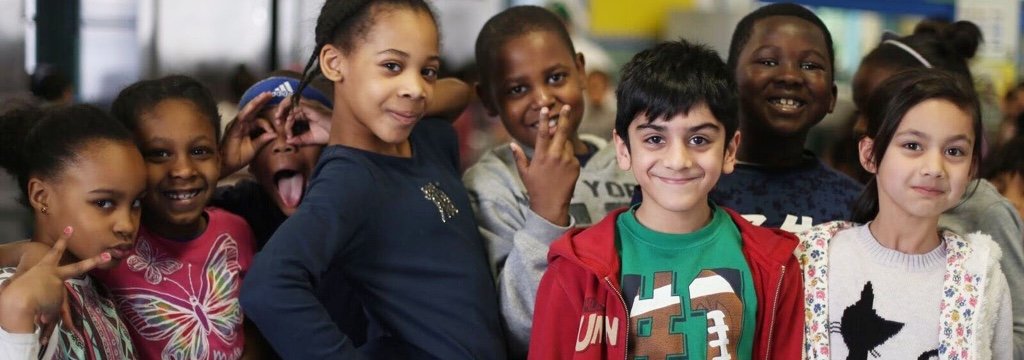Get more from InsideSchools
Battery Park City School
Share this school
Manhattan NY 10280
Our Insights
What’s Special
Sleek, airy "green" building; great science programs; Spanish instruction starting in 1st grade
The Downside
Large class sizes and no lockers for middle school students
PS/IS 276 The Battery Park City School boasts splendid views of the Hudson River and the Statue of Liberty from its home inside New Yorks first green public school building. Opened in 2009 to alleviate overcrowding in nearby schools, PS/IS 276 quickly has established itself as a popular neighborhood school with a strong science program, lots of extra enrichment activities and Spanish instruction starting in 1st grade.
The vibe throughout the school is cheery and relaxed. Students call their teachers and principal Theresa Ruyter by their first names. During group and independent work, particularly in the lower grades, its common to find students spread out across the classroom, some on the rug or in a corner and others at their desks.
Writing is emphasized in all subjects and there seems to be a nice balance between nonfiction and more creative writing. The hallways are lined with student work, ranging from reflections on math equations and engineering problems to student-authored fantasy stories and poetry.
All elementary school students have science instruction twice a week, though teachers also weave in science during other times. Hands-on learning is emphasized in all grades and teachers do a good job of tying science into other subjects. For example, as part of a 3rd-grade social studies unit on Africa, students read about a Malawian boy who built a windmill to power his familys home in The Boy Who Harnessed the Wind, and then built their own windmills as part of a tie-in study on engineering and sustainable energy. Three science teachers hold science classes are in one of the schools three well-equipped labs. By 8thgrade, students study challenging topics such as genetics and learn to write detailed lab reports in preparation for the demands of high school science.
Students also take an active role in the schools green programs. They plant vegetables in a rooftop garden, convert their leftover food scraps to compost and separate recyclables from garbage in clearly marked bins throughout the building.
The school relies on a variety of math curriculums that they tailor to different grades and pushes in extra help during math lessons. Its common to find two or three adults in a room during a math lesson, each working with a small group of students. Students are expected to learn multiple methods for solving problems and to explain their work in detail. Fourth-graders learn to divide using the traditional algorithm with remainders, by using compatible numbers (numbers close in value to those in the equation, which might be more easy to work with), and mental math. By 8th-grade students tackle challenging assignments, such as writing lengthy descriptions of exponential growth patterns. Algebra is offered to select 8th-graders based on teacher observations and class grades.
Lower school students get Spanish instruction twice weekly starting in 1st grade. Middle school students have Spanish three times a week. Theres also the option for independent foreign language study with the computer programRosetta Stone for students who are pulled out of class of lot for special services or who are foreign language phobic, says Ruyter. Students in all grades have art, music and gym classes. Band is offered starting in 4th grade and students in 3rd grade and lower have library once a week.
The lower and middle school grades are mostly kept apart, with different lunch periods, and most classes on separate floors. Class sizes are large in the middle school and there are no lockers, so middle school students store their coats in their homeroom class. The schools gym is large enough to be used for practice by nearby high schools and there is an outdoor track and a small play area with climbing equipment. The large, airy library is open to students during lunchtime recess. A sound-proof music room is used exclusively by the lower school.
Manhattan Youth runs a fee-based after school program that goes until 6 pm. Students can also participate in a variety of lunch clubs such as chess, drama, and puzzles for the lower school and TED talks, improvisation, community service and chorus for the middle school.
Special education: A modified form of Integrated Co-Teaching (ICT) is offered in some grades, where a special education teacher splits her time between two classes, each led by a general education teacher and each serving a mix of general education students and small groups (five or six) of students with special needs. In other grades, special education teachers work with students in classrooms and on a pull-out basis.
Admissions: For elementary school, priority to zoned students. For middle school, priority to continuing 5th-graders, then to zoned students, and then to District 2 students or residents. For the latter two groups, the school will give additional preference to students who demonstrate interest by signing in at an information session, school tour, open house or at a middle school fair. (Laura Zingmond, February 2014)
Read more
Comments